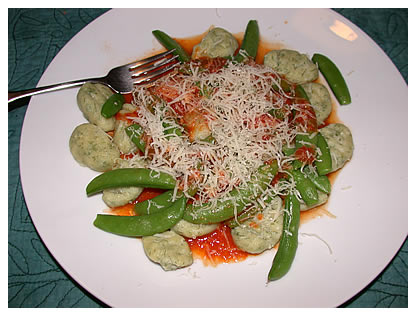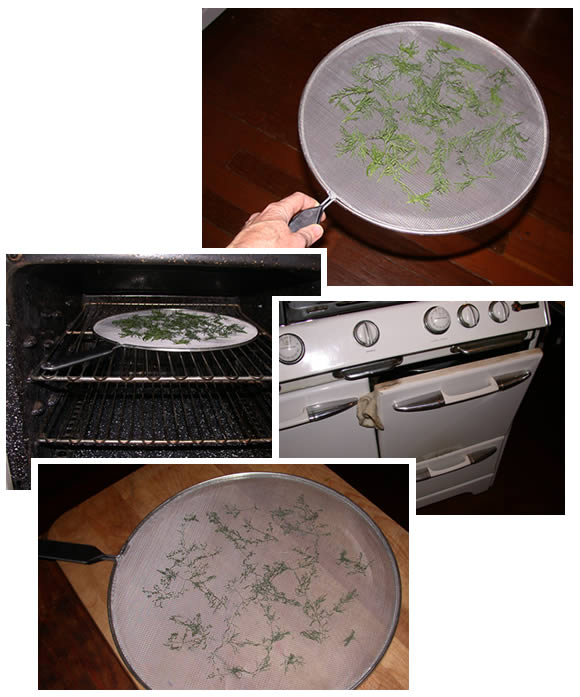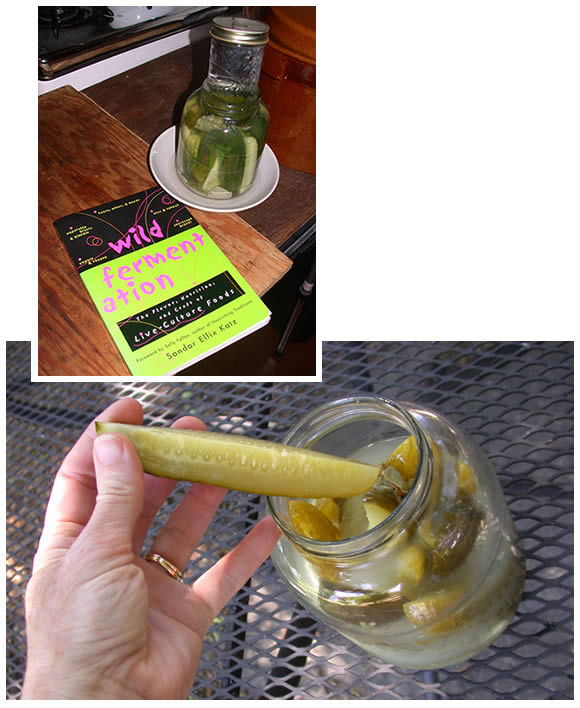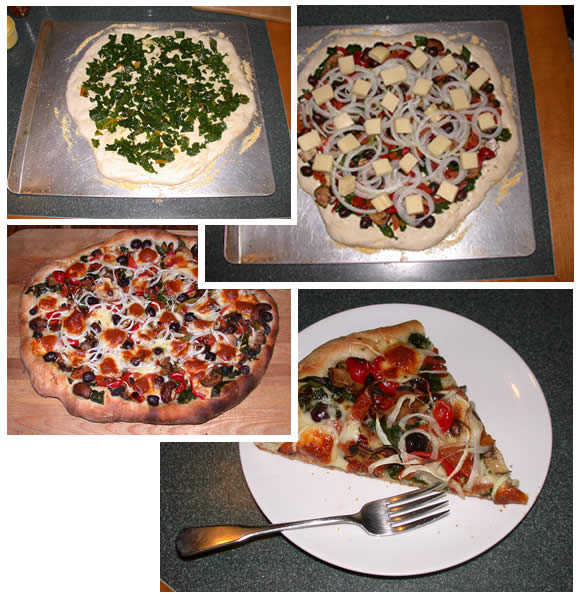Notes from Debbie's Kitchen~~~~~~~~~~~~~~~~~~~~~~~~~~~~~~~~~~~~~~~~~~~~~~~~
Click here to go to the recipe database.I'm so glad we're getting dill again, because I've got a new recipe to share! Lots of carrots in the Family share lately, so if you're not a juicer, let's see what other things we can come up with for them. Of course my friend and neighbor (and fellow CSA member) Mary Hall would say, "Just pack a few for your lunch every day! How hard is that?" They are sweet and delicious, so she's got a good point!
- Debbie
. . . . . . . . . . . . . . .
Ricotta-Dill GnocchiI made this up last night, as my dill from last week needed to be used ASAP or it was going to be history. Sometimes the most delicious things spring out of necessity! serves 2 generously
very easy to make; doubles easily
1/2 lb. fresh ricotta*
1 tsp. salt
1 small egg
1/4 C grated fresh Parmesan cheese
1/2 to 1 bunch fresh dill, fronds removed from stems and finely chopped
1/2 to 1 C flour
*[If your ricotta is on the wet side, place it in some cheesecloth in a colander (or something like that) over a plate to drain away the extra whey. Leave it sit in your refrigerator for a couple hours, or even overnight.]

In a bowl, combine ricotta, egg, salt and cheese and whisk/stir with a fork until everything is completely incorporated. Blend in minced dill. Add flour and mix to form a kneadable dough: start with just a half cup, and see how that goes. If it is still sticky, add more, a little at a time, until it comes together and you can handle it. Try not to add too much; additional flour will be incorporated when shaping the gnocchi.
Either break apart with your hands or cut the dough into four pieces with a knife. Generously sprinkle a cutting board with more flour.
Shape each piece of dough into a fat log, then roll out into a rope of roughly 1/2" to 3/4" in diameter. (Do you remember making coil pots out of clay when you were a kid? It's a lot like that! And just as fun!)
Cut dough into segments about an inch long; roll each segment into an ovoid
in your hands, using more flour as needed. Then roll the dough
ball against the tines of a fork to create interstices for any sauce
to cling to. You can make the balls then roll them against a fork
one by one, or you can make all the balls, then roll them all against
the fork. Whatever works for you!
Have a cookie sheet or another cutting board or something sprinkled lightly with additional flour standing by, and place the prepared gnocchi on it. If you're going to be freezing them for use later, put them on a lightly floured sheet of waxed paper on a cookie sheet then pop this into the freezer. Once frozen, they can then be decanted into a ziploc bag and returned to the freezer.
Regardless of whether they are fresh or frozen, you cook them the same way:
Bring a large pot of water to a boil (salt like you would for pasta). Drop the gnocchi in and stir a little bit to get the water moving so they don't drop to the bottom and stick. The gnocchi are done when they float to the surface! Fresh gnocchi cook very quickly; frozen, only a little longer. Remarkably fast though. The only thing to know is that you want to keep the water at a boil, so if you're cooking frozen gnocchi, don't add them all at once or the water may drop below boiling temperature.
Once cooked, they're ready to serve! You can serve them simply, of course, drizzled with a little good olive oil and maybe grating some additional Parmesan cheese on top, or be creative with your saucing! I made a very simple red sauce -- a garlic-lemon-butter-tomato sauce (melted butter, added minced garlic, squeezed in lemon juice, then added tomato puree that I'd put up from last summer's tomatoes; simmered this down maybe five minutes. That was it.) I also steamed up the sugar snap peas and combined them with the gnocchi, then topped them with the sauce and more cheese. Yum! You could also use green beans :-)
Drying Dill, cont'dI talked about
drying dill last week, but then came up with another surface to dry it on (instead of cheesecloth on a rack on a cookie sheet)... a splatter screen! I didn't dry that much in this example, but you get the idea. Scatter fronds on screen, place in oven with pilot light (or if no pilot, set to veerrrryy low, like 150 or less), prop door ajar and let dry. With the pilot light, it was dry in about 24 hrs. then crumble between your fingers into a small bowl then transfer to a jar. It should still smell very 'fresh' and 'dilly'.
 Making your own dill pickles the real way: fermentedThis is extremely fun and very rewarding! And since we've been getting pickling cucumbers... what better thing to make with them? (Although they are perfectly delicious as an eating or salad cucumber too.)
Making your own dill pickles the real way: fermentedThis is extremely fun and very rewarding! And since we've been getting pickling cucumbers... what better thing to make with them? (Although they are perfectly delicious as an eating or salad cucumber too.)My favorite book on this is Sandor Katz' "Wild Fermentation". Here are some excerpts from his section on making 'sour pickles':
"...As it turns out, brine pickles are easy. You just need to give them regular attention in the summer heat, when cucumbers are most abundant. ... One quality prized in a good pickle is crunchiness. Fresh tannin-rich grape leaves placed in the crock [or jar] are effective at keeping pickles crunchy. ... The biggest variables in pickle-making are brine strength, temperature, and cucumber size. ... I don't worry about uniformity of size; I just eat the smaller ones first, figuring the larger ones will take longer to ferment. ... [regarding brine strength,] a general rule of thumb to consider in salting your ferments: more salt to slow microorganism action summer heat; less salt in winter when microbial action slows."
 Tools and ingredients
Tools and ingredients:
<> Fresh cucumbers, unpeeled
<> a clean quart jar (mayonnaise, canning; in the example pictured, I just used an old pickle jar)
<> a clean smaller jar (that will fit within the mouth of the quart jar), filled with water (for weighting down the pickles while they ferment)
<> water - filtered or distilled (you don't want chlorine in there as
chlorine kills microorganisms, which in this case, we want!)
<> salt -
either Kosher, pickling, or unrefined sea salt. Don't use regular table
salt. Check the label: you don't want salt with iodine and
'anti-caking' agents put there to make it 'free flowing.' Iodine is also
antimicrobial, so you want to avoid it for the same reasons you avoid
chlorine in the water.
<> garlic - several cloves, peeled
<> peppercorns - 1/4 to 1/2 tsp.
<> fresh dill (a couple sprigs - more if you like your pickles 'dilly')
<> grape leaves
(optional, to help keep pickles crunchy)
Brine: 1 tbsp. salt to 1 1/2 C filtered water worked for me.
Dissolve the salt thoroughly in the filtered water.
The process: if you have one, put a grape leaf at the bottom of the jar. Add garlic cloves, peppercorns and dill. I cut my cucumbers into spears because that way I could fit more in the jar. Pack spears in tightly (more pickles in the end!). Optionally top with another grape leaf. Pour brine over all to cover, weight them down with the smaller jar (filled with water) -- this keeps them submerged -- and place this in a bowl on your counter. [The bowl captures any overflow of brine; it expands as they ferment, and if you fill your jar too full, like I tend to do, it slops over.]
Time: You should have pickles within a week. The batch I just made (shown) took five days. Keep in mind that fermentation is a process that happens over time, there is no
exact 'done' time - ferment for shorter periods of time and the results
will be more salty; longer fermentation produces more sour. Use your
senses of taste and smell. And remember, the pickles will continue to ferment, albeit a lot more slowly, in the refrigerator.
Observations: the cucumbers will turn from bright green to olive as they ferment. The brine will also turn cloudy, but this is what it is supposed to do - don't let it throw you! There was even a fine white sediment of sorts on the tops of my pickles...
Once the pickles smell 'pickley', remove the weighting jar, first swiping off any foam that may have bubbled up around the rim while fermenting, and taste them. You can stick your finger in the brine and see if it tastes sour; if it still seems more salty than sour, put the jar back in and let 'em ferment a little longer. Once soured to your liking, put a lid on and refrigerate them.
The final word: for those who are new to this or at all worried, be
assured that
you cannot get botulism from fermented veggies! See this
short youtube video Sandor Katz made to explain. Then rest easy! :-)
Chard or Kale PizzaYou've probably heard me say this before, but pizza is a great platform for your cooking greens. In this example, I used chard - but kale is also great!Pizza is very versatile; you don't have to have tomato sauce, or even tomatoes. In this example, I topped my pizza with:
Sauteed chopped chard
Thawed frozen mixed peppers (from the farm, but Trader Joes also makes a 'melange a trois' frozen bagged mixed peppers)
Sauteed mushrooms
Nicoise olives
Cut up dried apricots (try it! it's delicious!)
Sliced onion
Chunks of mozarella cheese
See my
recipe for pizza dough and how to bake it [you have to scroll down on the page]. Simply top the dough with whatever fun things you like --
pan browned radicchio would also be a yummy addition -- then bake as directed.
 Oops... carrots! I was going to give you a carrot recipe. Here goes, then I need to format pictures and send this newsletter out! ;-)Carrot-apple puree
Oops... carrots! I was going to give you a carrot recipe. Here goes, then I need to format pictures and send this newsletter out! ;-)Carrot-apple pureeAnother yummy-easy. Scrub and cut several carrots into chunks. Place in a pan with water to cover (or almost cover). Add a little salt. Bring to a boil, turn down to a simmer then cover and cook ten minutes or so, until tender. While carrots are cooking, peel, core, and chunk up an apple. Add this to the pot for the last minute or two of cooking (the apple will soften quickly). Cool slightly, and place carrots and apple in a blender, adding enough of the cooking water so that they will puree. Return puree to pan to heat before serving. If you added too much water in the pureeing process, just simmer it a little while to evaporate the excess water.